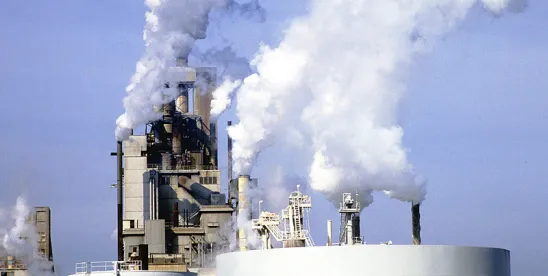On November 25, 2014, EPA issued a proposal to revise the National Ambient Air Quality Standards (“NAAQS”) for ozone. The Federal Register will publish the proposed rule in the coming days, and interested parties will be able to comment for ninety days from the date of publication. EPA plans to hold three public meetings regarding the proposed rule in January 2015. The dates, times, and locations of these meetings will be published separately in the Federal Register.
The Proposed Rule
The current primary and second NAAQS for ozone are both 0.075 parts per million (“ppm”). EPA proposes to lower both to “within the range of 0.065 ppm to 0.070 ppm;” to add an Appendix U to 40 CFR Part 50 detailing data selection, reporting, and handling requirements for ozone standards; to revise ambient monitoring requirements for ozone; and to add a grandfathering provision to the Prevention of Significant Deterioration (“PSD”) permitting program, exempting pending permits from the revised ozone standards.
Under the existing 2008 ozone NAAQS, EPA currently lists twenty-seven states (including the District of Columbia) that are in nonattainment. Under the proposed ozone NAAQS, EPA estimates that approximately forty-five states (including D.C.) would contain nonattainment areas, but that a “vast majority” of nonattainment counties would achieve attainment by 2025 “without taking additional action to reduce emissions.”
Revised Primary Standard
EPA proposes to lower the primary ozone standard to “within the range of 0.065 ppm to 0.070 ppm,” and to retain the indicator (ozone), the averaging time (8 hour), and the form (annual fourth-highest daily maximum, averaged over 3 years). In light of the Clean Air Scientific Advisory Committee’s recommendation of a range between 0.060 ppm to 0.070 ppm, EPA is soliciting comments on whether a standard as low as 0.060 ppm would be appropriate. EPA also proposes conforming changes to the Air Quality Index. An ozone concentration equal to the primary standard would equal 100 on the index.
Revised Secondary Standard
EPA proposes to lower the secondary ozone standard to within the same range as the primary standard, “0.065 ppm to 0.070 ppm.” EPA states that the standard should provide increased protection against “vegetation-related effects” on public welfare. The standard derives from EPA’s conclusion that “air quality in terms of a three-year average seasonal W126 index value, based on the three consecutive month period within the [ozone] season with the maximum index value, with daily exposures cumulated for the 12-hour period from 8:00 am to 8:00 pm, within the range from 13 ppm-hrs to 17 ppm-hrs would provide the requisite protection against known or anticipated adverse effects to the public welfare.” EPA solicits comments on this conclusion. Notably, EPA is considering, and also solicits comments on, whether the W126 three-year average form would be more appropriate than the proposed ppm form.
Data Selection and Reporting
EPA proposes to retain its required data collection methods and its “site combination” method. However, it proposes to combine data from monitors across an entire site, rather than isolate each ozone monitor as it currently does. EPA also proposes a new procedure for determining daily maximum, 8-hour average ozone concentrations because it concludes that the current method allows for “double counting” and that “overlapping daily maximum 8-hour averages are more likely to contribute to additional exceedances of the [ozone] NAAQS as the level of the standard is lowered.” The new procedure splits up the day into three periods 7am to 3pm, 3pm to 11pm, and 11pm to 7am.
Ambient Monitoring for Ozone
EPA proposes to lengthen the ambient ozone monitoring seasons for thirty-three states whose ambient ozone concentrations exceeded 0.060 ppm on days outside of the existing ozone monitoring seasons. EPA established these seasons because ozone is not a problem in many states during portions of the year when solar radiation decreases. The increases in ozone monitoring seasons range from one month to seven months, depending on the state. EPA also proposes to revise the following aspects of the Photochemical Assessment Monitoring Stations (“PAMS”) monitoring requirements: network design, volatile organic compound ("VOC") sampling, carbonyl sampling, nitrogen oxide sampling, and upper air meteorology measurements. EPA requires PAMS in all nonattainment areas that are classified as serious or above.
PSD Grandfathering Provision
EPA proposes a grandfathering provision for two categories of pending PSD permit applications: (1) “applications for which the reviewing authority has formally determined that the application is complete on or before the signature date of the revised NAAQS,” and (2) “applications for which the reviewing authority has first published a public notice of a draft permit or preliminary determination before the effective date of the revised NAAQS.” Grandfathered permits will have to comply with the ozone NAAQS that were in effect when the permit application was submitted, not the new revised NAAQS. The grandfathering provision applies to VOCs and NOx insofar as they contribute to ambient ozone. EPA further proposes that states that administer federal PSD permit programs have the discretion to “grandfather” pending PSD permits in the same manner.




 />i
/>i

